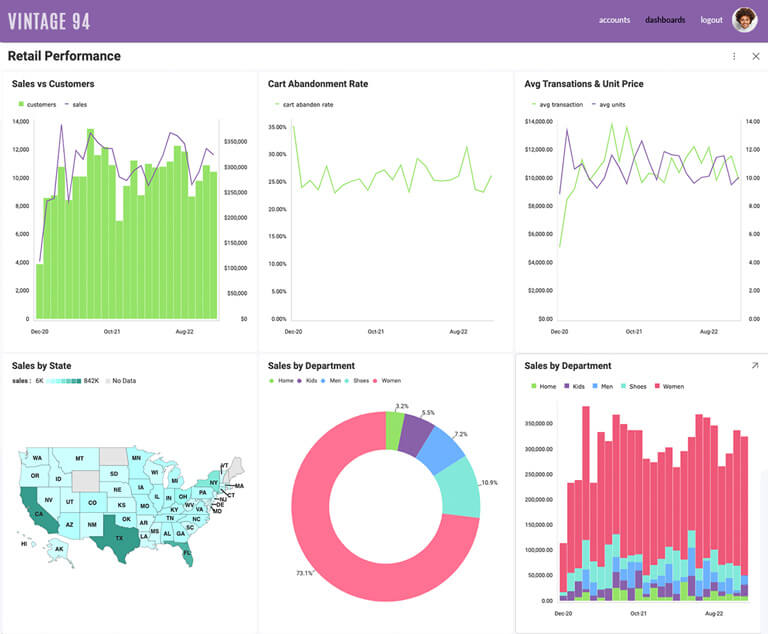
Scriptly Helps Pharmacies Identify Trends in Real Time with Reveal
Data from shopping cards, POS transactions, stock orders, and more is overwhelming the retail industry. This data alone, however, is not enough to streamline in-store operations, gain insights into customer behavior, optimize the customer experience and improve promotions. Retail analytics helps retail companies gain a single source of truth and improve their decision-making process, making decisions around sales, operations, and marketing better, smarter, and most of all data-driven.
Watch a Demo BOOK A PERSONALIZED DEMO Request a Demo FREE TRIAL

Retail analytics reveals important insights about inventory, operations, customers, and sales. These insights can help retail professionals to forecast future sales and demands and optimize their pricing strategies – data can suggest cross-selling and up-selling strategies based on the customer’s purchase history. With the help of retail analytics, retailers can keep track of how empty or full their stocks are and make sure to provide the number of products needed accordingly. Retail marketing also benefits from analytics as it assists marketers to plan future campaigns targeting their audiences more accurately.
In-store analytics is valuable asset for retailers, as it provides them with a profound understanding of the consumers behavior inside the store and tracks their shopping patterns. This unlocks many opportunities to optimize all operations in-store be it staffing options, design layout techniques, selling tactics, and more.
Real-time access to data gives retailers the ability to better predict future demands and inventory levels based on historical data. The insights gained from that data help guide decisions and support retail companies to forecast customers’ buying needs and accordingly manage the inventory.
Retail is a highly competitive market. Retaining customers and drawing new ones in is a challenging task, especially when all of your competitors are trying to distract your customers and take them away from you. Retail analytics identifies customers engaging with your brand, who could be a long-term and frequent buyer, who hasn’t recently shopped, or which customer preferences are being met. By knowing that, retailers can deliver strategic promotion and offers to engage further and retain customers.
Bringing the value of analytics to your business and being able to forecast trends with its help set pricing strategies in any direction. You can also track your competitors’ prices, audience and more to know when and how much you can increase or decrease your prices in order to maximize your profits and sell more with a higher margin.
Retail dashboards are used to track, monitor and display retail KPIs, store performances, inventory levels, margin, profits and more valuable insights related to retail to help professionals in this industry gain deeper understanding of how they perform and how they can improve.

Retailers use store performance dashboards to make it easier to analyze and visualize performance across a single store or a group of store locations. It helps compare budget revenues and profits across stores and answers key questions such as what the proportion of buyers over visitors to the store is.

Wannt to know what the order cycle time is, inventory efficient ratio, how many items were returned over a given period of time? The retail inventory management dashboard gives you a clearer picture of essential inventory KPIs. These insights help inventory managers improve and speed up the product purchasing and inventory planning process and reduce returns, and ultimately lose money.

Retailers who sell online use and benefit from an ecommerce dashboard. This dashboard displays insights into what is selling online, how much you’re earning from those sales, get an overview of daily / monthly results, base decisions on facts, trends, and historical knowledge, and lots more.
Embedded analytics integrates analytical solutions and data visualization capabilities into a retail software application’s user interface to improve data comprehension and usability. The real-time access to current and historical data that embedded analytics provides allows retailers to predict future demands and inventory levels better.
Imagine a retail company facing the challenge of optimizing inventory management across multiple locations. By leveraging embedded analytics, the company can seamlessly integrate advanced inventory tracking and forecasting tools directly into its point-of-sale systems. This integration empowers it to monitor stock levels in real-time, predict demand fluctuations, and streamline supply chain operations.
Retail analytics software is a set of tools and technologies that bring the power of data to retailers so they can harness their data, view performance in real time and derive actionable insights to help them optimize and grow.
Back to Top